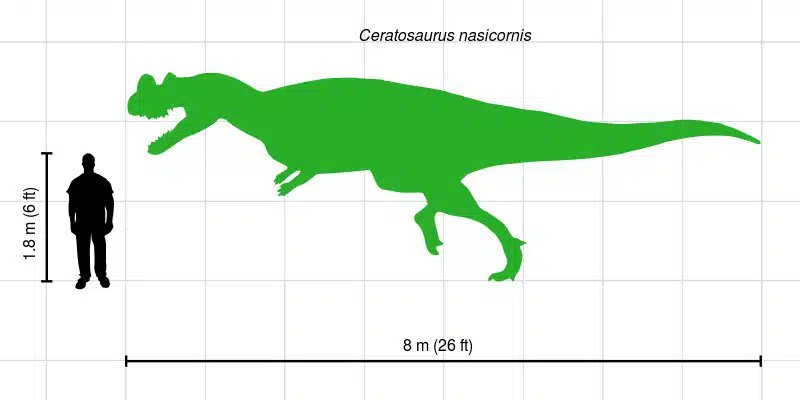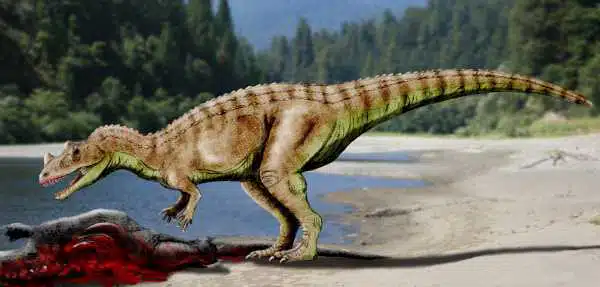Ceratosaurus was a predatory dinosaur from the theropoda group that lived during the Late Jurassic Period. It was first discovered in the late 19th century in Colorado USA. Its characteristic features, such as the large nasal horn and the row of osteoderms along its body, are a testament to the evolutionary creativity that characterized this era.
Ceratosaurus is a fascinating subject of study, not just for its unique physical characteristics but also for the insights it provides into the environment and ecosystem of the Late Jurassic period. In this article I will dive into all we know about it, but I’ll also discuss the environment it lived in, and some of the other dinosaurs it shared it with.
Key Facts
| Ceratosaurus pronunciation | sr-a-tow-saw-ruhs |
| Meaning of name | Horned lizard |
| Group | Theropoda |
| Type Species | Ceratosaurus nasicornis |
| Diet | Carnivore |
| When it Lived | 157.3 to 145.0 MYA |
| Period | Late Jurassic |
| Epoch | Late/Upper Kimmeridgian to Early/Lower Tithonian |
| Length | 19.7 to 23.0 ft |
| Height | 6.5 ft |
| Weight | 1.1 ton |
| Mobility | Moved on two legs |
| First Discovery | 1883 by Marshall Parker Felch |
| Location of first find | Colorado, USA |
| First Described by | 1884 by Othniel Charles Marsh |
| Holotype | USNM 4735 |
Ceratosaurus Origins, Taxonomy and Timeline

Ceratosaurus‘ name is derived from the Greek words “keras” meaning horn and “sauros” meaning lizard (dinosaur). The type species name is C. nasicornis, which means “nose horn'” a fitting name for a creature known for its large nasal horn.
Ceratosaurus belongs to the Ceratosauridae family, known for their horned skulls. They are part of the Theropoda group, a clade of bipedal dinosaurs that includes some of the most well-known species such as Tyrannosaurus and Velociraptor.
Within this family, the Ceratosaurus nasicornis is the best known species. It lived during the Late Jurassic period, specifically during the Late Kimmeridgian to Early Tithonian, between 157.3 to 145.0 MYA.
Listen to Pronunciation
Fossil Evidence

The first discovery of a Ceratosaurus was made in 1883 by Marshall Parker Felch in Garden Park in Colorado, USA. It it part of the Morrison Formation which stretches across the Western United States.
The find consisted of a nearly complete skeleton. It was later described in 1884 by Othniel Charles Marsh, providing a more detailed understanding of this fascinating creature. The fossil was well-preserved and allowed paleontologists to gain a detailed understanding of this new dinosaur’s physical characteristics.
Since that initial discovery, quite a few additional fossils have been found in various locations around the world. These include Portugal, Tanzania, and Uruguay, as well as other parts of the United States such as Oklahoma, Utah, and Wyoming. The number of finds in these regions varies, with the United States boasting the most at 13. The grest number of fossil remains, and the wide geographical range points to it having been a ‘success’ in the dinosaurs evolution.
The fossils found have included a variety of bones, providing a comprehensive picture of its physical structure. Many of these fossils have been well-preserved, allowing scientists to study the dinosaur’s unique features such as its large nasal horn and the row of osteoderms along its body. These features have given us a glimpse into Ceratosaurus’s life and behavior and have provided valuable insights into this fascinating creature.
Ceratosaurus Size and Description
Ceratosaurus was a large theropod dinosaur known for its distinctive physical features. Its body was robust and muscular, built for hunting and scavenging. The head was large and adorned with a prominent nasal horn—the feature that gives the Ceratosaurus its name. The neck was strong and flexible to support the large head and allow the dinosaur to strike quickly at prey.
The vertebrae were sturdy and provided a strong backbone for the dinosaur. The limbs were powerful and the hind limbs being longer than the forelimbs. Like many theropod dinosaurs it had really short forelimbs compared to many other dinosaurs. The tail was long and muscular to provide balance and aid in locomotion. The skin is believed to have been covered in scales, similar to modern reptiles.
Size and Weight of Type Species

I have to point out that with so many discoveries, there are a few different estimations of the size of an adult Ceratosaurus nasicornis. Some differences might also be due to varied age of the specimens, where some might have been juveniles, rather than fully grown adults.
It was no doubt a large predator, with paleontologists estimating its length to be somewhere between 18 to 23 feet long. This size made it one of the larger predators of the Late Jurassic period. However, despite its size, Ceratosaurus was not the largest predator of its time, with other theropods such as Allosaurus being larger.
The weight is estimated to have been between around 900 to 1500 lbs, however there are some outlier estimates outside of this scoipe as well. This weight combined with its size would have made Ceratosaurus a terrifying predator.
Ceratosaurus in Detail
One of the most distinctive features of Ceratosaurus is its large nasal horn. This horn, combined with the row of osteoderms along its body, probably gave it a daunting appearance. The horn is believed to have been used for display purposes, possibly to attract mates or intimidate rivals.
It also had a row of small, bony pieces of armor running along its back. These osteoderms may have served a protective function, shielding the dinosaur from attacks by other predators or rivals. They could also have played a role in display and helped the Ceratosaurus to assert dominance or attract mates.
Another unique feature of Ceratosaurus was its teeth. It had long, slender teeth in its upper jaw, which could be over nine centimeters long. These long teeth would have been a weapon that were capable of inflicting deep wounds on prey animals. The reason for the length of these teeth is not entirely clear, but they may have been an adaptation for a specific hunting strategy or prey type.
Ceratosaurus in its Natural Habitat
This carnivore lived during the Late Jurassic period, a time characterized by a warm, lush climate and diverse vegetation. Its diet likely included plant-eating dinosaurs, but some scientists have suggested that it may have also fed on aquatic animals such as fish, turtles, and crocodiles.

Ceratosaurus was a bipedal dinosaur, moving on two legs. This mode of locomotion would have allowed it to move quickly and efficiently in pursuit of prey. It could also have given it an advantage in hunting, as it could use its forelimbs to grasp and hold onto prey.
Ceratosaurus was likely a solitary hunter that relied on its speed and power to take down prey. However, it’s also possible that it may have engaged in some form of social behavior, such as forming hunting packs or defending territories. The presence of horns and osteoderms could suggest that it engaged in displays or contests of dominance, similar to some modern animals.
Interesting Points about Ceratosaurus
- It had a row of sharp horns on its head, a feature that sets it apart from many other theropods.
- Despite its size and formidable appearance, this was not the largest predator of its time. Other theropods, such as the Allosaurus, were larger.
- It had long, slender teeth in its upper jaw that could be over nine centimeters long. These teeth could inflict deep wounds on prey.
- It had a row of small, bony pieces of armor running along its back. These osteoderms may have served a protective function or played a role in display.
- As a carnivore, its diet likely included plant-eating dinosaurs. However, some scientists have suggested that it may have also fed on aquatic animals such as fish, turtles, and crocodiles.
Contemporary Dinosaurs
With a geographical range that spread across this world, it shared its world with a compelling group of contemporaries. These fellow dinosaurs, each unique in their own right, contributed to the intricate dance of existence, their lives woven into a complex web of survival and competition.
Allosaurus, a larger predator, roamed these ancient lands alongside Ceratosaurus. Their potential encounters paint a vivid picture of the survival of the fittest, a reminder of the relentless cycle of life and death. Despite their shared predatory nature, the Ceratosaurus and Allosaurus were not mere reflections of each other. They were distinct, each adapted in its own way to the challenges of their shared world.
Apatosaurus and Diplodocus, on the other hand, were gentle giants of their time. These colossal herbivores used their long necks to reach for the treetops, presenting a stark contrast to the carnivorous Ceratosaurus. Yet, their coexistence speaks volumes about the diverse and dynamic ecosystem they were part of. Ceratosaurus would have been dwarfed by these titanic creatures despite its fierce nature, adding another layer of complexity to their potential interactions.
Stegosaurus adds another fascinating dimension to this prehistoric scene with its iconic plates and spikes. This herbivore was not as massive as Apatosaurus or Diplodocus but still presented a difficult challenge to any potential predator—including Ceratosaurus. The possible encounters between Ceratosaurus and Stegosaurus, whether in competition or mere passing, serve to further illustrate the intricate and diverse nature of their shared world.
List of All Dinosaurs
We have created a list of all dinosaurs we have covered here, sorted across the seven main groups of dinosaurs. We also include information about their type of diet, (omnivore, herbivore or carnivore) and the time they lived.
Frequently Asked Questions
The name translates to “horned lizard,” a fitting name for a dinosaur known for its large nasal horn.
It belongs to the Theropoda group, a clade of bipedal dinosaurs that includes some of the most well-known species such as the Tyrannosaurus and Velociraptor.
It lived during the Late Jurassic period, around 155.7-145.0 million years ago.
This dinosaur was a carnivore and so its diet likely included plant-eating dinosaurs. Some scientists have suggested that it may have also fed on aquatic animals such as fish, turtles, and crocodiles.
Sources
- https://www.ajsonline.org/content/s3-16/95/411
- https://www.biodiversitylibrary.org/item/65465#page/9/mode/1up
- https://www.sciencedirect.com/science/article/abs/pii/S0195667114002201
- https://www.researchgate.net/publication/40664332_The_large_theropod_fauna_of_the_Lourinha_Formation_Portugal_and_its_similarity_to_the_Morrison_Formation_with_a_description_of_a_new_species_of_Allosaurus
- https://www.jstor.org/stable/20490962
Article last fact-checked: Marius, 01-02-2025
Featured Image Credit: Debivort at English Wikipedia, CC BY-SA 3.0, via Wikimedia Commons
